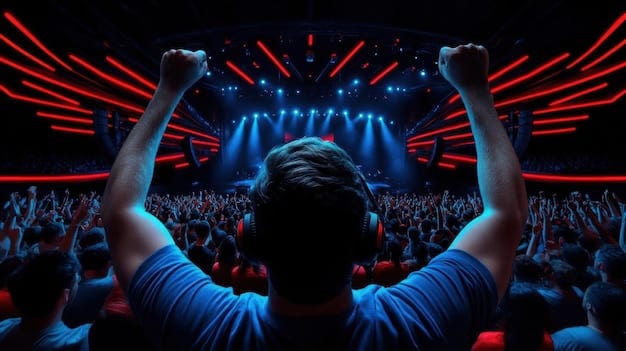Will Esports Player Association Reshape Pro Contracts by 2025?

The formation of a new Esports Player Association has sparked considerable debate within the competitive gaming community. The crucial question looms: will the new Esports Player Association impact pro contracts in 2025? This emerging entity seeks to safeguard player rights, negotiate fair terms, and establish industry standards. Its potential to reshape the landscape of professional esports contracts is significant, but the exact nature and extent of its influence remains to be seen.
Understanding the Esports Player Association
Esports Player Associations are organizations designed to represent and advocate for the interests of professional esports players. These associations aim to address key issues such as fair contracts, better working conditions, and improved overall treatment within the esports industry.
The Role of Player Associations
Player Associations play a critical role in ensuring that esports professionals have a voice. They negotiate with leagues, teams, and sponsors to establish standards that protect players’ rights and promote a more equitable environment.
Key Objectives
The primary objectives often include securing minimum salaries, health benefits, and standardized contract terms. By collectively bargaining, players can achieve improvements that might be unattainable individually.
- Advocating for fair contract terms
- Ensuring adequate health and retirement benefits
- Promoting fair treatment and working conditions
Player associations provide a framework for ensuring that professionals can address concerns. Promoting fair and transparent dealings within esports are the primary goals.

Current State of Esports Contracts
Esports contracts have historically been a contentious issue, often criticized for lacking standardization and failing to adequately protect players. Understanding the current landscape is essential to appreciating the potential impact of a player association.
Common Issues in Esports Contracts
Many esports contracts lack transparency, leaving players vulnerable to exploitation. Non-standardized terms and conditions can create confusion and uncertainty for both players and teams.
Impact of Non-Standardization
The absence of uniform standards can lead to disputes and legal challenges. Players may find themselves bound to unfavorable terms, with limited resources to challenge unfair practices.
- Lack of transparency in contract terms
- Uneven bargaining power between players and organizations
- Inadequate protection for players’ rights
Addressing the pitfalls of the existing contracts is key. This ensures a more stable and secure professional environment for esports athletes.
Potential Impact on Pro Contracts in 2025
The formation of a robust Esports Player Association could significantly alter the landscape of professional esports contracts by 2025. The association can bring several critical changes, offering better protection and standards for players.
Standardized Contracts
One of the primary impacts could be the introduction of standardized contract templates. This would ensure that all players have access to fair and transparent terms, reducing the risk of exploitation.
Improved Player Rights
The association can advocate for improved player rights, including the right to fair compensation, health insurance, and retirement benefits. This would bring esports in line with more established professional sports.
- Negotiating collective bargaining agreements
- Establishing minimum standards for player compensation
- Ensuring access to health and retirement benefits
A successful Association can ensure that contracts are fair, transparent and equitable to all involved.

Challenges and Obstacles
Despite the potential benefits, the formation of a successful Esports Player Association faces numerous challenges. Overcoming these hurdles is crucial to achieving meaningful change.
Resistance from Organizations
Some esports organizations may resist the formation of an association, fearing it will erode their control and increase costs. Building trust and cooperation is essential.
Achieving Unity Among Players
Uniting players with diverse backgrounds and interests can be difficult. Overcoming individual rivalries and short-term goals requires strong leadership and a shared vision.
Legal and Regulatory Hurdles
Navigating the legal and regulatory landscape can be complex, especially given the global nature of esports. Compliance with various laws and regulations is essential.
Navigating these significant challenges is essential for the association to successfully protect the interests of players.
Case Studies of Successful Player Associations in Other Sports
Examining successful player associations in traditional sports can provide valuable insights and lessons for the esports industry. These organizations have paved the way for improved player rights and working conditions.
National Basketball Players Association (NBPA)
The NBPA has a long history of advocating for NBA players, negotiating collective bargaining agreements that address salaries, benefits, and working conditions.
Major League Baseball Players Association (MLBPA)
The MLBPA transformed professional baseball by securing free agency and improved compensation for players. Their model offers valuable lessons for esports.
- Collective bargaining for improved compensation
- Securing free agency rights for players
- Establishing health and retirement benefits
By studying these models, the Esports Player Association can learn from past successes and avoid common pitfalls.
Future Predictions for 2025 and Beyond
Looking ahead to 2025 and beyond, several predictions can be made about the future of esports contracts and the influence of player associations. The evolution of contracts will depend on the success and actions of these organizations.
Increased Professionalization
The continued professionalization of esports will likely lead to more standardized and comprehensive contracts. Player associations will play a key role in driving this change.
Greater Player Empowerment
As players become more aware of their rights and the power of collective bargaining, they will demand greater control over their careers. Player associations can facilitate this empowerment.
- Rise of player-led initiatives and negotiations
- Increased scrutiny of contract terms by legal experts
- Greater enforcement of player rights
Predicting the future ensures continuous progress and the evolution of fair practices within the gaming community.
| Key Point | Brief Description |
|---|---|
| 🤝 Player Associations | Organizations advocating for esports player rights and fair treatment. |
| 📜 Current Contract Issues | Lack of standardization, transparency, and adequate player protection. |
| 🔮 Future Impact | Potential for standardized contracts, improved rights, and greater professionalization. |
| 🏀 Lessons from Other Sports | Insights from NBA and MLB player associations on collective bargaining. |
FAQ
An Esports Player Association is an organization that represents professional esports players, advocating for their rights and fair treatment within the industry. They aim to improve contract terms and promote equity.
These associations are crucial for ensuring that esports players have a collective voice when negotiating contracts and addressing workplace conditions, preventing individual vulnerabilities and potential exploitation in non-standard contracts.
The goals typically include establishing standardized contracts, securing fair compensation and health benefits, and promoting a transparent and equitable environment for professional esports athletes to work efficiently.
Challenges include resistance from organizations, difficulty uniting players with differing interests, and navigating complex legal and regulatory landscapes, all requiring strategic approaches and leadership capabilities.
By studying successful models like the NBA and MLB player associations, esports organizations can gain insights into effective collective bargaining, player empowerment, and establishing beneficial industry standards.
Conclusion
In conclusion, the establishment of an Esports Player Association has the potential to significantly impact pro contracts by 2025. By addressing issues such as contract standardization, player rights, and professionalization, the association could reshape the esports landscape for the better, ensuring fairness and equity for all players involved.





